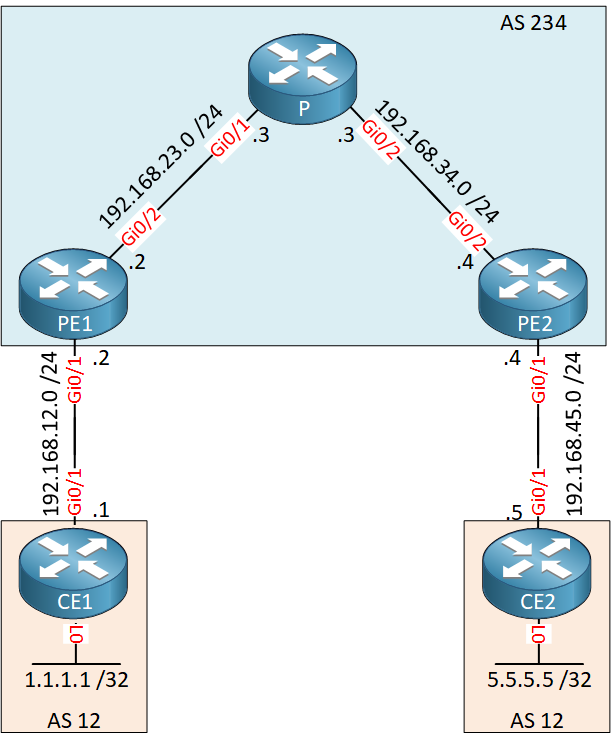External BGP uses a simple loop prevention mechanism: when you see your own AS number in the AS path, we don’t accept the prefix. There are some scenarios where this might be an issue. Take a look at the following topology:

Above we have a MPLS VPN network where the customer is using the same AS number (12) on both sites. CE1 and CE2 will be unable to learn each others prefixes since they are using the same AS number.
Let’s see if this is true, here are the configurations of all routers if you want to test this yourself:
- Configurations
- CE1
- PE1
- P
- PE2
- CE2
Here you will find the startup configurations of each device.
Each CE router has a loopback interface that was advertised in BGP (1.1.1.1/32 and 5.5.5.5/32). The first thing to check is to see if the PE routers have learned the prefixes from our CE routers:
PE1#show ip bgp vpnv4 all
Network Next Hop Metric LocPrf Weight Path
Route Distinguisher: 1:1 (default for vrf CUSTOMER)
*> 1.1.1.1/32 192.168.12.1 0 0 12 i
*>i 5.5.5.5/32 4.4.4.4 0 100 0 12 iPE2#show ip bgp vpnv4 all
Network Next Hop Metric LocPrf Weight Path
Route Distinguisher: 1:1 (default for vrf CUSTOMER)
*>i 1.1.1.1/32 2.2.2.2 0 100 0 12 i
*> 5.5.5.5/32 192.168.45.5 0 0 12 iAbove you can see that both PE routers have a VPN route for these prefixes. Did they advertise these prefixes to our CE routers?
PE1#show ip bgp vpnv4 all neighbors 192.168.12.1 advertised-routes
BGP table version is 16, local router ID is 2.2.2.2
Status codes: s suppressed, d damped, h history, * valid, > best, i - internal,
r RIB-failure, S Stale, m multipath, b backup-path, f RT-Filter,
x best-external, a additional-path, c RIB-compressed,
Origin codes: i - IGP, e - EGP, ? - incomplete
RPKI validation codes: V valid, I invalid, N Not found
Network Next Hop Metric LocPrf Weight Path
Route Distinguisher: 1:1 (default for vrf CUSTOMER)
*>i 5.5.5.5/32 4.4.4.4 0 100 0 12 i
Total number of prefixes 1 PE2#show ip bgp vpnv4 all neighbors 192.168.45.5 advertised-routes
BGP table version is 18, local router ID is 4.4.4.4
Status codes: s suppressed, d damped, h history, * valid, > best, i - internal,
r RIB-failure, S Stale, m multipath, b backup-path, f RT-Filter,
x best-external, a additional-path, c RIB-compressed,
Origin codes: i - IGP, e - EGP, ? - incomplete
RPKI validation codes: V valid, I invalid, N Not found
Network Next Hop Metric LocPrf Weight Path
Route Distinguisher: 1:1 (default for vrf CUSTOMER)
*>i 1.1.1.1/32 2.2.2.2 0 100 0 12 i
Total number of prefixes 1No issues there, our PE routers are advertising these prefixes to the CE routers. Let’s see what we find in the BGP tables of the CE routers:
CE1#show ip bgp
Network Next Hop Metric LocPrf Weight Path
*> 1.1.1.1/32 0.0.0.0 0 32768 iCE2#show ip bgp
Network Next Hop Metric LocPrf Weight Path
*> 5.5.5.5/32 0.0.0.0 0 32768 iThe CE routers only have their own prefixes in their BGP tables. Why did they refuse the updates from the PE routers? Time for a debug:
CE1#debug ip bgp all updates
BGP updates debugging is on for all address familiesLet’s reset the BGP neighbor adjacency:
CE1#clear ip bgp *Here’s what you will see on the CE1 router:
CE1# BGP(0): 192.168.12.2 rcv UPDATE about 5.5.5.5/32 -- DENIED due to: AS-PATH contains our own AS;
As expected, the CE1 router denies the update since it sees its own AS number in the AS path. If we don’t want to change our AS numbers then there’s two ways to deal with this:
- Use Allow-AS in to overrule the loop prevention mechanism of external BGP.
- Use AS override to change the AS number on the PE routers.
- Unit 1: Introduction
- Unit 2: LDP (Label Distribution Protocol)
- Unit 3: MPLS VPN
- VRFs (Virtual Routing and Forwarding)
- MPLS L3 VPN Explained
- MPLS L3 VPN Configuration
- MPLS L3 VPN BGP Allow AS in
- MPLS L3 VPN BGP AS Override
- MPLS L3 VPN PE-CE RIP
- MPLS L3 VPN PE-CE EIGRP
- MPLS L3 VPN PE-CE OSPF
- MPLS L3 VPN PE-CE OSPF Default Route
- MPLS L3 VPN PE-CE OSPF Global Default Route
- MPLS L3 VPN PE-CE OSPF Sham Link
- VRF Lite Route Leaking
- MPLS VPN Extranet Route Leaking
- MPLS VPN VRF Export Map
- MPLS VPN VRF Import Map
- MPLS over FlexVPN
- Unit 4: MPLS L2 Encapsulation
- Unit 5: IPv6 MPLS
- Unit 6: MPLS Traffic Engineering (TE)
- Introduction to MPLS Traffic Engineering (TE)
- MPLS Traffic Engineering (TE) IS-IS Configuration
- MPLS Traffic Engineering (TE) OSPF Configuration
- MPLS TE RSVP-TE
- MPLS TE Static Routes
- MPLS TE Policy Based Routing (PBR)
- MPLS TE Autoroute Announce
- MPLS TE Autoroute Destination
- MPLS TE Autoroute Metric
- MPLS TE Unequal Cost Load Balancing
- MPLS TE Load Balancing between IGP and TE
- MPLS TE Forwarding Adjacency
- MPLS TE Path Options Explicit
- MPLS TE Class-Based Tunnel Selection (CBTS)
- MPLS TE Metric
- MPLS TE Setup and Hold Priority
- MPLS TE Attribute Flag and Affinity
- MPLS TE Reoptimization
- MPLS TE Fast Reroute (FRR)
- MPLS TE Fast Reroute Path Link Protection
- MPLS TE Fast Reroute Path Node Protection
- MPLS TE FRR RSVP Hello Support
- MPLS TE DiffServ Aware (DS-TE) Traditional
- MPLS TE Diffserv-Aware (DS-TE) IETF Mode
- MPLS VPN over MPLS TE Tunnels
- MPLS TE Per VRF TE tunnel